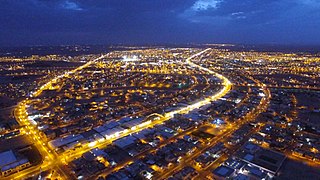
The Bedouin, Beduin, or Bedu are pastorally nomadic Arab tribes who have historically inhabited the desert regions in the Arabian Peninsula, North Africa, the Levant, and Mesopotamia (Iraq). The Bedouin originated in the Syrian Desert and Arabian Desert but spread across the rest of the Arab world in West Asia and North Africa after the spread of Islam. The English word bedouin comes from the Arabic badawī, which means "desert-dweller", and is traditionally contrasted with ḥāḍir, the term for sedentary people. Bedouin territory stretches from the vast deserts of North Africa to the rocky ones of the Middle East. They are sometimes traditionally divided into tribes, or clans, and historically share a common culture of herding camels, sheep and goats. The vast majority of Bedouins adhere to Islam, although there are some fewer numbers of Christian Bedouins present in the Fertile Crescent.

Najd is the central region of Saudi Arabia, in which about a third of the country's modern population resides. It is the home of the House of Saud, from which it pursued unification with Hejaz since the time of the Emirate of Diriyah.

Al-Jawf Province, also spelled Al-Jouf, is one of the provinces of Saudi Arabia, located in the north of the country, partially bordered by Jordan to the west. It is one of the earliest inhabited regions of Arabian Peninsula, with evidence of human habitation dating back to the Stone Age and the Acheulean tool culture. Human settlement continued unbroken throughout the Copper Age, a period that saw the kingdom of Qidar fight against the Assyrian state for its independence. It is also in this period that references to Arabs first appear in historical texts. A Christian kingdom later emerged under the rule of the Bani Kalb tribe and survived until the arrival of Islam and the Islamic conquest of Al-Jawf. Following the region's Islamization it fell under the control of the Tayy tribe. Al-Jawf was incorporated into the third Saudi state at the time of its formation in 1932. In the 20th century the region was a site of conflict between the Al-Rashid family and the Al-Shaalan family, though it eventually came under the rule of King Abdulaziz bin Abdul Rahman Al Saud.

Diriyah, formerly romanized as Dereyeh and Dariyya, is a town and governorate in Saudi Arabia located on the northwestern outskirts of the Saudi capital, Riyadh. Diriyah was the original home of the Saudi royal family, and served as the capital of the Emirate of Diriyah under the first Saudi dynasty from 1727 to 1818. Today, the town is the seat of the Diriyah Governorate—which also includes the villages of Uyayna, Jubayla, and Al-Ammariyyah, among others—and is part of Ar Riyad Province.

Rass is a Saudi Arabian City, located in Al Qassim Province. It lies southwest of Buraydah, the capital of the province and north of Riyadh, the national capital.

The Banu Abs are an ancient Bedouin tribe that originated in central Arabia. They form a branch of the powerful and numerous Ghatafan tribes. They still inhabit the Arabian Peninsula and North Africa but have spread to many other regions of the world, as well. Their descendants today include the large Al Qubaisat tribe located in United Arab Emirates, Bani Rasheed tribe located in Saudi Arabia, Qatar, Yemen, Kuwait, United Arab Emirates, Oman, Sudan, Eritrea, and Jordan, and the Banu Rawaha located mostly in Oman and the UAE. They are known to be the second strongest tribe after The Prophet's Tribe. Parts of the Mahas tribe of the Butana region in Sudan are also linked by blood to the Banu Abs due to intermarriage between the Sudanese Rashaida tribe and the Mahas peoples. One of the earliest stories concerning this tribe was the famous classical love and war story of Antar and Abla.

The Beni Sakhar confederacy is one of the largest and most influential tribal confederacies in both Lebanon and Jordan. Its founder, Sakher bin Tha'labah al Tayy likely lived in the 3rd century AD, making the tribe around 18 centuries old. The Bani Sakher began migrating to The Levant as early as the 16th century and grew to become an influential tribe as by around the mid 18th century. The Beni Sakher is made out of many clans, both through ancestry and alliances. These clans are primarily separated into three groups, Al-Twaqa headed by the princely Al-Fayez family, Al-Ka'abneh headed by the Khreisha family, and Al-Khdeir.

Al-Dawasir is an Arabian tribe in the Arabian Peninsula. Its main base is in the south of Najd in the governorates of Wadi Al-Dawasir, As Sulayyil, Al-Aflaj, and Al-Kharj. The tribe is an affiliation of 2 groups: the Taghlib Bani Wael and Al-Zayd Al-Azd. The Al-Dawasir tribe is among the most powerful and influential tribes of Arabia, as they are the maternal uncles of much of the House of Saud family.

Harb is an Arab tribe in the Arabian peninsula. It is originally a Qahtanite tribe. Some sources on Arab tribes' genealogy state that the great-grandfather of the Harb tribe is Harb ibn Saad ibn Saad ibn Khawlan ibn Amr ibn Qadha'ah ibn Himyar ibn Qahtan. Harb tribal lands extend from the Red Sea coast in Tihamah to the heart of Najd in the central region of Saudi Arabia, and from North the Harbi lands extend from Madinah to Al Qunfudhah in the south. The tribe's reach extends to other Arab countries like Kuwait, Iraq, Bahrain and UAE.

Eastern Arabia (Bahrain), is a region stretched from Basra to Khasab along the Persian Gulf coast and included parts of modern-day Bahrain, Kuwait, Iraq, Eastern Saudi Arabia, United Arab Emirates, Qatar, Oman. The entire coastal strip of Eastern Arabia was known as "Bahrain" for a millennium.

Al-Ghamdi is an Arabic family name denoting a member of the Ghamd tribe of Saudi Arabia.

Banu Yam is an Arabian tribe that belongs to the Qahtanite branch of Arabian tribes, specifically the group known as Banu Hamdan, and are, therefore, native to southwestern Arabia.

Bani Khalid is an Arab tribal confederation mainly inhabiting the Arabian Peninsula. The tribe ruled southern Iraq, Kuwait, and Eastern Arabia from the 15th century to the 18th century, and again under the auspices of the Ottoman Empire during the early 19th century. At its greatest extent, the domain of Bani Khalid extended from Iraq in the north to the borders of Oman in the South, and Bani Khalid wielded political influence by ruling the region of Najd in central Arabia. Most of the tribe's members presently reside in eastern and central Saudi Arabia, while others live in Iraq, Kuwait, Qatar, Bahrain, Syria, Palestine, Lebanon and the United Arab Emirates. Bani Khalid has both Shia Muslim and Sunni Muslim members.
Banu Hanifa is an ancient Arab tribe inhabiting the area of al-Yamama in the central region of modern-day Saudi Arabia. The tribe belongs to the great Rabi'ah branch of North Arabian tribes, which also included Abdul Qays, Taghlib, al-Nammir ibn Qasit, and Anazzah. Though counted by the classical Arab genealogists as a Christian branch of Bani Bakr, they led an independent existence prior to Islam. The ruling House of Saud of Saudi Arabia belongs to it.

Anizah or Anazah is an Arabian tribe in the Arabian Peninsula, Upper Mesopotamia, and the Levant.

Accurate religious demographics are difficult to obtain in Saudi Arabia, but there are approximately 2.1 million Christians in Saudi Arabia in 2020. Christians in Saudi Arabia are reported to face widespread discrimination and harassment, including both foreign-born Christians and native Christians.

Uyayna is a village in central Saudi Arabia, located some 30 km (19 mi) northwest of the Saudi capital Riyadh. Uyayna was the birthplace of Muhammad ibn Abd al-Wahhab. Today, Uyayna is a small village and forms together with its neighbor al-Jubayla the Subgovernorate of Uyayna and Al-Jubayla, with a combined population of 4,000. The subgovernorate is part of the Governorate of Dir'iyyah, which in turn is part of Riyadh Province.
The Ghamd is an Azd Arab tribe of the Hejaz Region. They are predominantly Sunni, and are considered one of the oldest tribes of the Arabian Peninsula. The Ghamid people are thought to be closely related to the neighboring tribe of Zahran.

Jalan Bani Bu Ali is a commercial town and tourist destination in Oman.

Qaryat Al Faw was the capital of the first Kindah kingdom. It is located about 100 km south of Wadi ad-Dawasir, and about 700 km southwest of Riyadh, the capital city of Saudi Arabia. The Al Faw archeological site reveals various features such as residential houses, markets, roads, cemeteries, temples, and water wells.

















